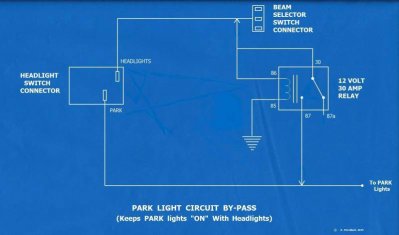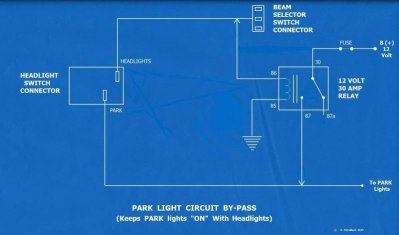Wildaugust
Senior Member
There was a thread on here not too long ago where some of us were discussing the way the Park Lights on pre-'69 cars and trucks were wired. The fact that the Park lights turn "off" when the Headlight switch is pulled all of the way out to the Headlights "on" position, was mentioned.
This got me thinking. My other project is a '69 F-100 and it just happens to be wired that way too. The Park lights turn "on" when the switch is pulled out to the first click, but then turn "off" when the switch is pulled all of the way out to the Headlights "on" position. I started thinking of a way to keep the Park lights on with the Headlights and I came up with this idea. I suppose there are other people who have done this, but I haven't seen it. The only suggestions that I found recommended just using a jumper wire on the rear of the Headlight Switch Connector, between the Headlight terminal and the Park light terminal.
Obviously, jumping the Headlight terminal to the Park light terminal at the switch would keep the Park lights on with the headlights. However, to my way of thinking, it would also allow electricity to flow in the other direction, meaning power would be flowing to the headlights while the switch is in the Park light position. This wouldn't be good IMO, because the headlights would be getting power when the switch is pulled out to the first click. Power would be flowing to the headlights through the Park light terminal, possibly overloading that part of the Headlight Switch. The entire load would be on the Park light circuit, including the fuse for the Park lights, possibly blowing it as well.
In order to prevent this situation, you could use a relay to "jump" the two circuits. This way the Park lights could remain on with the headlights, but the headlights would still be isolated from the Park lights when the switch is only pulled to the first click. Also, if the relay were to fail, the Headlights and Park lights should still work the way they always did. If you are already using Headlight Relays, this should work without any issues. If you don't have Headlight Relays, the extra load of the Park lights, approximately 2 Amps, will be added to your Headlight circuit. This extra load could be enough to make the circuit breaker in your Headlight Switch cycle on and off. If that happens you will need to use Headlight Relays in order to use this idea.
Here's the idea that I came up with for my truck. This circuit should work with most classic cars and trucks where the Park lights turn "off" when the Headlights are turned "on". It likely will not work if your car has side Marker lights at the front.

I thought I'd share my idea in case it may help someone wanting to do this, or just be of interest.

This got me thinking. My other project is a '69 F-100 and it just happens to be wired that way too. The Park lights turn "on" when the switch is pulled out to the first click, but then turn "off" when the switch is pulled all of the way out to the Headlights "on" position. I started thinking of a way to keep the Park lights on with the Headlights and I came up with this idea. I suppose there are other people who have done this, but I haven't seen it. The only suggestions that I found recommended just using a jumper wire on the rear of the Headlight Switch Connector, between the Headlight terminal and the Park light terminal.
Obviously, jumping the Headlight terminal to the Park light terminal at the switch would keep the Park lights on with the headlights. However, to my way of thinking, it would also allow electricity to flow in the other direction, meaning power would be flowing to the headlights while the switch is in the Park light position. This wouldn't be good IMO, because the headlights would be getting power when the switch is pulled out to the first click. Power would be flowing to the headlights through the Park light terminal, possibly overloading that part of the Headlight Switch. The entire load would be on the Park light circuit, including the fuse for the Park lights, possibly blowing it as well.
In order to prevent this situation, you could use a relay to "jump" the two circuits. This way the Park lights could remain on with the headlights, but the headlights would still be isolated from the Park lights when the switch is only pulled to the first click. Also, if the relay were to fail, the Headlights and Park lights should still work the way they always did. If you are already using Headlight Relays, this should work without any issues. If you don't have Headlight Relays, the extra load of the Park lights, approximately 2 Amps, will be added to your Headlight circuit. This extra load could be enough to make the circuit breaker in your Headlight Switch cycle on and off. If that happens you will need to use Headlight Relays in order to use this idea.
Here's the idea that I came up with for my truck. This circuit should work with most classic cars and trucks where the Park lights turn "off" when the Headlights are turned "on". It likely will not work if your car has side Marker lights at the front.

I thought I'd share my idea in case it may help someone wanting to do this, or just be of interest.


















